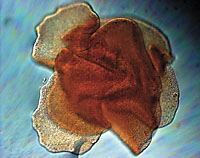 | Trichoplax adherens represent descendents of the oldest multi-celled animal. |
Yale scientists have offered new evidence that placozoans, animals that have only four body cell types and no structured organs, represent descendents of the oldest multi-celled animal, perhaps older even than sponges.
A recent paper in Proceedings of the National Academy of Sciences presents the complete sequence of the mitochondrial genome of Trichoplax, one of the first identified placozoans. The research was led by Stephen Dellaporta, professor of molecular, cellular and developmental biology, and Leo Buss, professor of ecology and evolutionary biology.
The scientists compared the placozoans' size, genes and gene arrangement to that of other mitochondrial genomes from "simple" multi-cellular animal life forms -- like cnidarians and sponges.
Mitochondria, often referred to as the "powerhouses" of the cell, are organelles that are characteristic of cells in higher organisms. Mitochondrial genomes have become more compact as evolution has progressed and animals have become more complex.
"The mitochondrial genome of Trichoplax, to date, is the largest found in multi-cellular animals and its structure, organization and sequence provides biomarkers that can be used to reconstruct pathways of the evolution of the earliest forms of animal life and relatedness between extant lower animal species," says Dellaporta. "It is over twice the size of mitochondrial genomes found in most animals and it contains genes, introns and spacer sequences more like those of single-celled organisms and fungi than of complex animals."
As primitive as Placozoa are, research from members of this group led by Ana Signorovitch, a recent graduate student of Buss, also showed that they contain signatures for sexual mode of reproduction not yet observed in placozoans.
The research -- an interdisciplinary effort enhanced by the expertise of investigators in fields of molecular evolution, invertebrate biology and ecology -- is part of a collaborative project on the origins of multi-cellularity that is supported by a National Science Foundation Genome-Enabled Environmental Science and Engineering Program grant and a Human Frontiers Science Program grant. Co-authors were Anthony Xu and Maria A. Moreno of Yale and Bernd Schierwater, Sven Sagasser and Wolfgang Jakob of Tieraerztliche Hochschule Hannover, Germany.
-- By Janet Rettig Emanuel
T H I S
Scientists trace evolution of one of
the earliest multi-cellular life forms W E E K ' S
W E E K ' S S T O R I E S
S T O R I E S![]()
 Yale launches podcast library on iTunes
Yale launches podcast library on iTunes![]()
![]()
 Japan gives top civilian honor to Yale scholar
Japan gives top civilian honor to Yale scholar![]()
![]()
 Lin: Great care needed in studying 'finicky' stem cells
Lin: Great care needed in studying 'finicky' stem cells![]()
![]()
 Yale SOM renames center in honor of Ira Millstein . . .
Yale SOM renames center in honor of Ira Millstein . . .![]()
![]()
 Grant supports research on risk factors for testicular cancer
Grant supports research on risk factors for testicular cancer![]()
![]()
 Researchers to study age-related decline of sense of smell
Researchers to study age-related decline of sense of smell![]()
![]()
 University begins mandatory training for faculty involved with grants
University begins mandatory training for faculty involved with grants![]()
![]()
 Coat color may not be indicator of species in lemurs, say researchers
Coat color may not be indicator of species in lemurs, say researchers![]()
![]()
 Scientists trace evolution of one of the earliest multi-cellular life forms
Scientists trace evolution of one of the earliest multi-cellular life forms![]()
![]()
 Study shows seat of emotions in the brain may also contribute . . .
Study shows seat of emotions in the brain may also contribute . . .![]()
![]()
 Troupe hopes to dispel stereotypes about ancient dance
Troupe hopes to dispel stereotypes about ancient dance![]()
![]()
 Nobel laureate to give public lecture on campus
Nobel laureate to give public lecture on campus![]()
![]()
 Colleagues to pay tribute to Bresnick in Carnegie Hall
Colleagues to pay tribute to Bresnick in Carnegie Hall![]()
![]()
 T.P. Ma honored for pioneering work with semiconductors
T.P. Ma honored for pioneering work with semiconductors![]()
![]()
 Symposium will examine filmmaker's 'European period'
Symposium will examine filmmaker's 'European period'![]()
![]()
 Panel will discuss reconciliation between Israelis, Palestinians
Panel will discuss reconciliation between Israelis, Palestinians![]()
![]()
 It is the jurists who will be judged at student mock trial tournament
It is the jurists who will be judged at student mock trial tournament![]()
![]()
 Renowned painting to remain on view at British Art Center
Renowned painting to remain on view at British Art Center![]()
![]()
 Gala to raise funds for research, treatment of reproductive cancers
Gala to raise funds for research, treatment of reproductive cancers![]()
![]()
 Campus Notes
Campus Notes![]()
Bulletin Home |
| Visiting on Campus
Visiting on Campus |
| Calendar of Events
Calendar of Events |
| In the News
In the News![]()
Bulletin Board |
| Classified Ads
Classified Ads |
| Search Archives
Search Archives |
| Deadlines
Deadlines![]()
Bulletin Staff |
| Public Affairs
Public Affairs |
| News Releases
News Releases |
| E-Mail Us
E-Mail Us |
| Yale Home
Yale Home